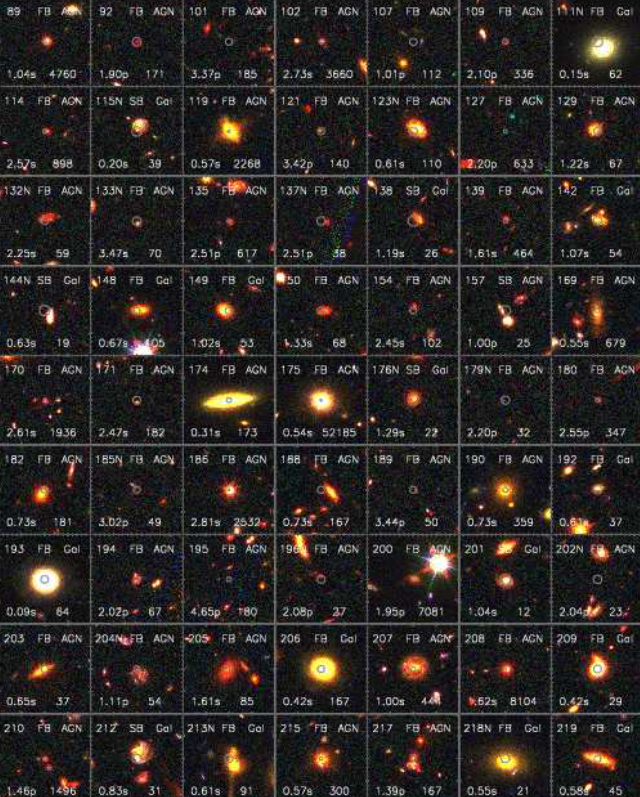 Postage-stamp images for the main-catalog sources that have GOODS-S and CANDELS coverage. The images are color composites of the GOODS-S b-band (blue), GOODS-S z-band (green), and CANDELS F160W-band (red) images. Each image is 12′′on a side, with the X-ray source indicated by a small central circle of radius equal to the 1σ X-ray positional uncertainty. The main-catalog ID number (a letter “N” is attached if the source is newly detected compared to the 4 Ms CDF-S catalogs), X-ray band, and source classification (AGN, galaxy, or star) are given at the top of each image; the numbers at the bottom are the adopted redshift (“−1” if not available; marked with “s” if it is a spectroscopic redshift or “p” if a photometric redshift) and the net source counts in the corresponding X-ray band. Only the first page is shown here for illustrative. Credit: Luo et al. 2016
Postage-stamp images for the main-catalog sources that have GOODS-S and CANDELS coverage. The images are color composites of the GOODS-S b-band (blue), GOODS-S z-band (green), and CANDELS F160W-band (red) images. Each image is 12′′on a side, with the X-ray source indicated by a small central circle of radius equal to the 1σ X-ray positional uncertainty. The main-catalog ID number (a letter “N” is attached if the source is newly detected compared to the 4 Ms CDF-S catalogs), X-ray band, and source classification (AGN, galaxy, or star) are given at the top of each image; the numbers at the bottom are the adopted redshift (“−1” if not available; marked with “s” if it is a spectroscopic redshift or “p” if a photometric redshift) and the net source counts in the corresponding X-ray band. Only the first page is shown here for illustrative. Credit: Luo et al. 2016
Astronomers took advantage of Chandra satellite’s unprecedented X-ray sensitivity, to create a new X-ray source catalogue. The new catalogue consists of 1008 sources that were revealed after ~81 days (7Ms) of exposure time and are located in a field astronomers call Chandra Deep Field South (CDFS). 992 of these sources have also been observed in other wavelengths (optical/NIR/IR) of the electromagnetic spectrum, thus vastly increasing the available information on these sources. The distance of 653 sources has been estimated from its spectrum and for 333 their distance has been calculated photometrically. 711 sources have been identified as Active Galactic Nuclei (AGN). The catalogue is an update of the previous (4Ms) X-ray source catalogue, adding 291 never observed before X-ray sources.
This new catalogue will help scientists investigate how Supermassive Black Holes (SMBHs) grow and co-evolve with galaxies and examine how the X-ray binary populations of starburst and normal galaxies evolve over most of cosmic time, among other exciting things.
Source: Luo et al. 2016
